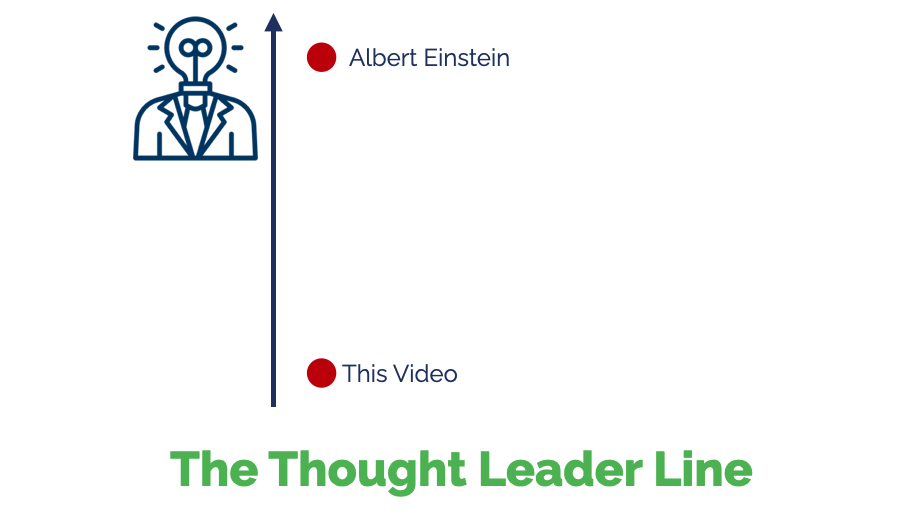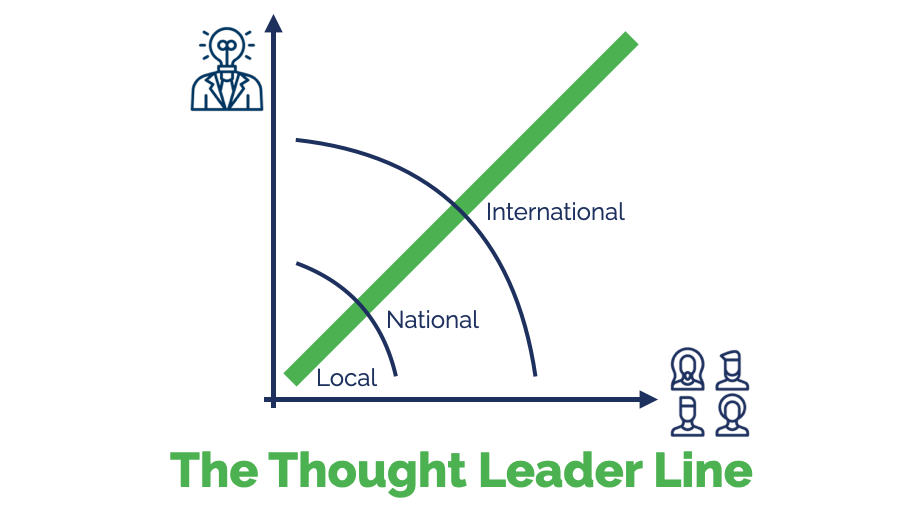Are you a thought leader?
The term thought leader can be a divisive one. Some people think they are one, others may disagree. Some people proudly claim to be one, while others think it’s only a term that others apply to you.
To answer the question, ‘What is a Thought Leader?’, I’ve asked four colleagues their thoughts on whether or not they think they are a thought leader – and why they came to that conclusion. Plus, I’ve added my thoughts at the end.
It might just answer the question you’ve been asking yourself: Are you a thought leader?
Here are the transcripts of what the four business experts said…
1 Suzanne Mercier

I specialize in limiting mindsets, and particularly in the imposter syndrome, which I’ve been working with for about 13 years. I’ve written a book on the subject, I actually have done quite a bit of speaking on the subject.
And I was part of a group called Thought Leaders many, many years ago. The group was actually all about helping people who had a unique idea or clever idea, help them become commercially successful. And so I think everybody in that group considered themselves to be thought leaders, it was a title that I always felt a little bit uncomfortable with.
And it wasn’t until recently that I understood why. First of all, there are so many people around calling themselves thought leaders at the moment. And I think that’s kind of diminished the impact of the title if you like.
The two criteria to be considered a thought leader
But the two criteria that I’ve been told are important to be considered to be a thought leader. The first one is actually that you have a unique idea – unique in terms of it’s never been done before, or a unique take on an idea that’s already out there in the market.
So from that perspective, I guess I was the thought leader because imposter syndrome was had not been taken into the business environment. And we hadn’t heard much about that in Australia either. So that was a tick.
But the second area was where I felt I tripped up, was that you need to have social proof – an enormous number of people following you. That suggests that it is something that is impacting other people. It’s not just a little flame burning in the dark, it’s actually something that is impacting a lot more people.
And I didn’t get that. I wasn’t there, the market wasn’t ready for me or I wasn’t ready to put the effort into the market at that point in time to build my profile further than I did already. So I guess I didn’t fit on that criteria.
So for me, I look at a lot of people who are calling themselves thought leaders. And I think no, I don’t think so. They’re not, they’re not fulfilling both of those criteria. So for me, no, I’m not a thought leader. I am definitely an expert in my area, though.
2 Lisa Carlin

But I always found it very hard to capture this into content and learnings for people because when I start explaining what I do, it sounds obvious. So I never thought of myself as a thought leader.
And then Geoff, you helped me to take some of this knowledge out of my head and put it into articles. Then I just started to write. This was probably about 10 years ago. And I really felt like I was a thought leader then.
And then I got distracted, delivering a whole lot of work.
And now I’m working in the Edtech talent management space with a lot of startup businesses and scale-ups. And as I work with them, I’ve pulled together a lot of my knowledge to be able to do this.
I realize now that actually, I am a thought leader. And I can do it on my own for now. And I’m doing it, I’m sharing and in fact, my writer’s block is now gone. I’ve done that by getting really clear on my purpose and my value add and the kind of work I want to do with the startup and scale-up businesses in the Edtech space in the learning space.
It really leverages the skills that I have really well around behaviour and insight into large HR departments and how they procure and how people in organizations work with customers. And I can do it because I’m clear on what I want.
And so yes, I do think I am a thought leader, but at times I haven’t been. So it’s an interesting question.
3 Taruni Falconer
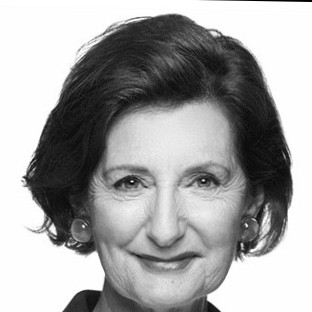
I’m sufficiently skilled in checking in with myself as to what’s really required here. And that keeps them as inspiring leaders actually. Because they have that, that mastery.
And how do they get it? They’ve been practising. And I often assist them, particularly with the ability to use deliberate practice and use the neurosciences and what we know about productivity, to capture that mastery.
Ultimately, that means they can trust themselves as leading others. And therefore the people around trust them and trust their decisions. That’s really important.
Yeah, so for a thought leader, you know, that’s something I’d always thought of as being in the hands of other people to decide. In other words, I’ve never actually named myself that. So it’s a very interesting question.
Who is a thought leader for me?
And, you know, what is a thought leader, for me, a thought leader is someone that gives me internal models and frameworks that I can easily quickly pull up inside as guidance.
And so actually, when I look across the span of my career, you know, 40 years plus, and I contact people that I’ve worked with coached, trained, facilitator, their teams, and over the years in different countries, they say to me, I still use that model, I still think of that framework when I’m in this situation. And therefore, I guess, I have been or am a thought leader, for others. I’m guessing so.
And I know that there are people that I look to, for guidance, and it’s their frameworks and their terminology they’ve given. For instance, Daniel Goleman and emotional intelligence – a really useful framework he gave us for interpersonal and intrapersonal intelligence. He extended the way we think about intelligence. Very useful.
Thought Leader. Yes. So yeah, I guess I’m a thought leader. And when I think about setting up the first intercultural communication training company in New Zealand, everyone said to me, we’re bicultural, we don’t need you. And I said we have the most diverse workforce in the world by citizenship. I think we’re multicultural and multilingual. So yes, we’re bicultural. But how about we change the way we think about our workforce.
So that was being a thought leader, I guess because it shifted perception. It shifted training tools, and it shifted the skill sets people had and that was the result.
4 Philippe Guichard

I have been called a thought leader, I’m not sure I would name myself a thought leader, but I’ve been called a thought leader because I take a position in the design industry.
So there are two things that set me kind of apart into the thought leadership realm. One is, I have a very specific methodology for launching and de-risking ventures hardware adventures. So it’s quite different from the traditional design process. The other thing that really differentiates me is the triple bottom line.
So when I design a product and when I talk to my client, I have this vision that we can also benefit the people and the planet.
Geoff’s Thoughts on Being a Thought Leader
Now, for my thoughts on this. And not like I have the right answer, more a case of this is the world according to Geoff.
For me, a thought leader is anyone who has people following or using their ideas.
For instance, in my previous post on Thought Leadership Strategy, I outlined a simple way to create a hyper-focus for your business. Several people told me they loved the framework and have used that to refine their business strategy. In my world, that makes me a thought leader.
I’m not going to run around calling myself that, but it does fit my general definition.
The Thought Leader Line
However, clearly, there is a big difference between my level of thought leadership and that of someone like one of the all-time greats, Albert Einstein.
This is a question of the scale of your ideas and the scale of your influence in terms of how many people use your ideas.
To show this visually, I’ve created a little diagram that might help you determine if you are a thought leader or not. I’ve called it the Thought Leader Line.
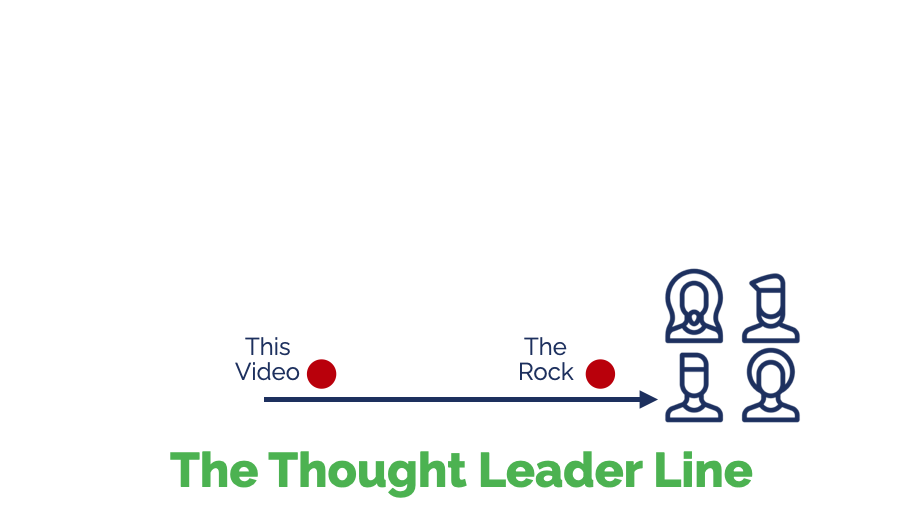
On the horizontal axis, we have leadership – or your level of influence and the breadth and depth of people that follow you or use your ideas. The further to the right on this axis, the more influence you have. For instance, in 2021, ex-wrestler and movie star Dwayne Johnson aka The Rock is the most popular person on the planet. He’d be on the right on this scale. And the much smaller audience watching this video would put this on the far left.
Now, it starts to get interesting when we draw a diagonal line between the two – the Thought Leader Line (the green line).
Seven Thought Leader Examples
We can start to plot a person’s level of thought leadership and also their strength around the quality of their ideas and the breadth of their influence.
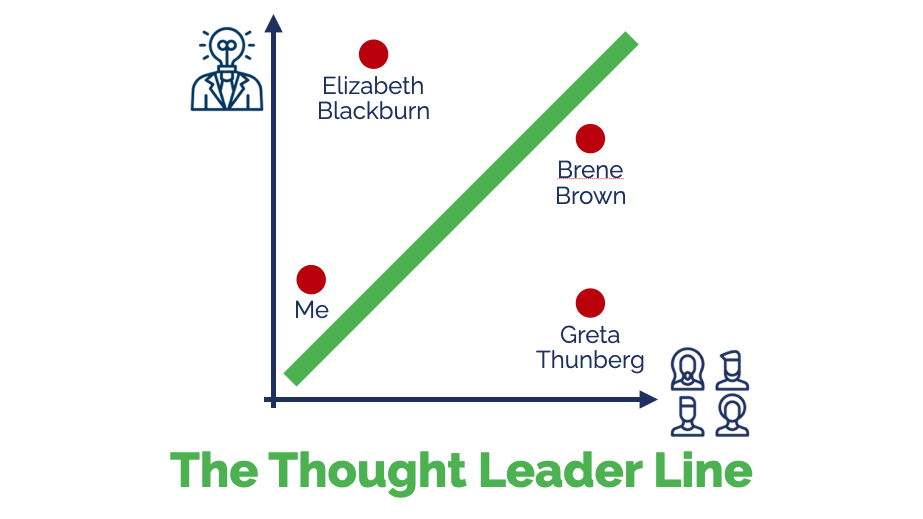
For example, Elizabeth Blackburn is a Nobel Prize-winning scientist which would put her high on the impact of her ideas. But because her work is so technical, she would probably score low on her level of social impact – she might be a hero in the scientific world but is relatively unknown outside of this.
On the other end of the spectrum, we have the climate change activist Greta Thunberg. While her ideas are probably not going to win her a Nobel Prize, the level of international support she has achieved might.
In the middle, we have someone like Brene Brown who has both strong ideas and a strong following.
And finally, down in the bottom left corner is someone like me who has some decent ideas and a small audience.
This shows there are a lot of different ways to be a thought leader and not all of them require you to be on the world stage.
The Real Value of the Thought Leader Line
The real value here is to plot yourself on this graph.
Where would you put yourself? And where would you like to be on this graph?
I’ve loosely put three bands across the graph to suggest you can have a local, national or international impact. This shows one way to show the scale of your thought leadership.
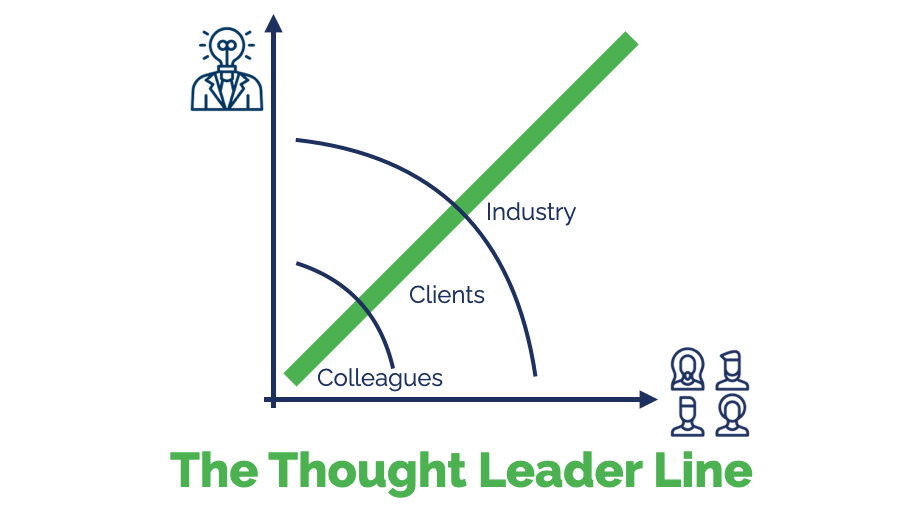
The other idea here is whether you would put yourself above the line, below it or perhaps on it. If you were above the line, it would mean your ideas are more influential than the number of people who use them. If you were below the line, it would mean you had a greater social impact than your ideas. And if you were on the line, you could say you have both – an audience that is equivalent to your level of ideas.
Let me know in the comments below where you would put yourself on this graph.
More on being a Thought Leader
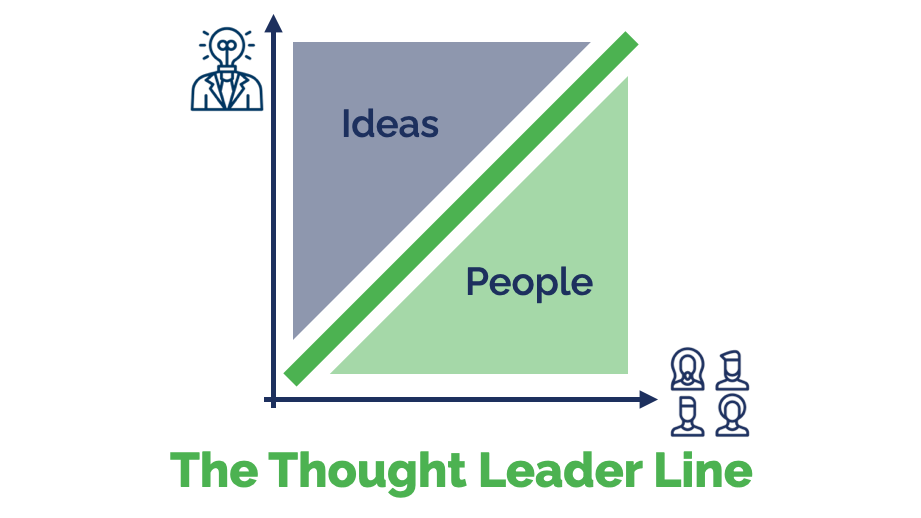
For more on being a thought leader you might like these posts and videos:
- Thought Leadership Meaning and Definition
- Thought Leadership Strategy
- What is Thought Leadership? – Seven World-Class Examples

